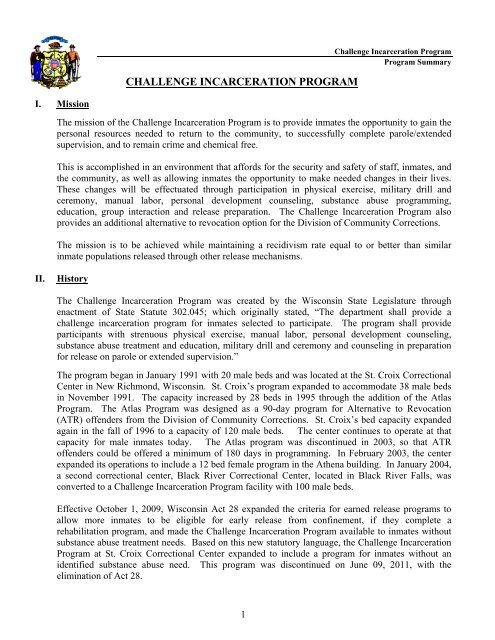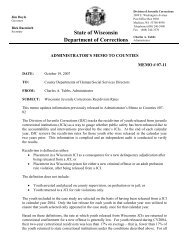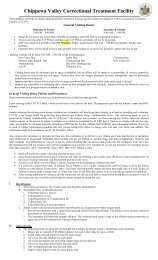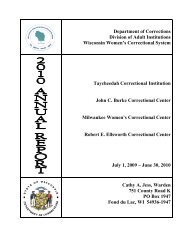Challenge Incarceration Program (CIP). - Wisconsin Department of ...
Challenge Incarceration Program (CIP). - Wisconsin Department of ...
Challenge Incarceration Program (CIP). - Wisconsin Department of ...
Create successful ePaper yourself
Turn your PDF publications into a flip-book with our unique Google optimized e-Paper software.
I. Mission<br />
CHALLENGE INCARCERATION PROGRAM<br />
1<br />
<strong>Challenge</strong> <strong>Incarceration</strong> <strong>Program</strong><br />
<strong>Program</strong> Summary<br />
The mission <strong>of</strong> the <strong>Challenge</strong> <strong>Incarceration</strong> <strong>Program</strong> is to provide inmates the opportunity to gain the<br />
personal resources needed to return to the community, to successfully complete parole/extended<br />
supervision, and to remain crime and chemical free.<br />
This is accomplished in an environment that affords for the security and safety <strong>of</strong> staff, inmates, and<br />
the community, as well as allowing inmates the opportunity to make needed changes in their lives.<br />
These changes will be effectuated through participation in physical exercise, military drill and<br />
ceremony, manual labor, personal development counseling, substance abuse programming,<br />
education, group interaction and release preparation. The <strong>Challenge</strong> <strong>Incarceration</strong> <strong>Program</strong> also<br />
provides an additional alternative to revocation option for the Division <strong>of</strong> Community Corrections.<br />
The mission is to be achieved while maintaining a recidivism rate equal to or better than similar<br />
inmate populations released through other release mechanisms.<br />
II. History<br />
The <strong>Challenge</strong> <strong>Incarceration</strong> <strong>Program</strong> was created by the <strong>Wisconsin</strong> State Legislature through<br />
enactment <strong>of</strong> State Statute 302.045; which originally stated, “The department shall provide a<br />
challenge incarceration program for inmates selected to participate. The program shall provide<br />
participants with strenuous physical exercise, manual labor, personal development counseling,<br />
substance abuse treatment and education, military drill and ceremony and counseling in preparation<br />
for release on parole or extended supervision.”<br />
The program began in January 1991 with 20 male beds and was located at the St. Croix Correctional<br />
Center in New Richmond, <strong>Wisconsin</strong>. St. Croix’s program expanded to accommodate 38 male beds<br />
in November 1991. The capacity increased by 28 beds in 1995 through the addition <strong>of</strong> the Atlas<br />
<strong>Program</strong>. The Atlas <strong>Program</strong> was designed as a 90-day program for Alternative to Revocation<br />
(ATR) <strong>of</strong>fenders from the Division <strong>of</strong> Community Corrections. St. Croix’s bed capacity expanded<br />
again in the fall <strong>of</strong> 1996 to a capacity <strong>of</strong> 120 male beds. The center continues to operate at that<br />
capacity for male inmates today. The Atlas program was discontinued in 2003, so that ATR<br />
<strong>of</strong>fenders could be <strong>of</strong>fered a minimum <strong>of</strong> 180 days in programming. In February 2003, the center<br />
expanded its operations to include a 12 bed female program in the Athena building. In January 2004,<br />
a second correctional center, Black River Correctional Center, located in Black River Falls, was<br />
converted to a <strong>Challenge</strong> <strong>Incarceration</strong> <strong>Program</strong> facility with 100 male beds.<br />
Effective October 1, 2009, <strong>Wisconsin</strong> Act 28 expanded the criteria for earned release programs to<br />
allow more inmates to be eligible for early release from confinement, if they complete a<br />
rehabilitation program, and made the <strong>Challenge</strong> <strong>Incarceration</strong> <strong>Program</strong> available to inmates without<br />
substance abuse treatment needs. Based on this new statutory language, the <strong>Challenge</strong> <strong>Incarceration</strong><br />
<strong>Program</strong> at St. Croix Correctional Center expanded to include a program for inmates without an<br />
identified substance abuse need. This program was discontinued on June 09, 2011, with the<br />
elimination <strong>of</strong> Act 28.
III. Overview<br />
The <strong>Challenge</strong> <strong>Incarceration</strong> <strong>Program</strong> is voluntary; however, all program elements are mandatory.<br />
<strong>Challenge</strong> <strong>Incarceration</strong> <strong>Program</strong> participants waive <strong>Department</strong> <strong>of</strong> Corrections Administrative Rules<br />
governing procedural matters for general population inmates, so that behaviors and consequences can<br />
be dealt with in a manner consistent with the mission <strong>of</strong> the program.<br />
The program is designed for the inmates to complete all program components in a minimum <strong>of</strong> 180<br />
days. <strong>Program</strong> components are structured around discipline and rehabilitative programming.<br />
Inmates are given an opportunity to develop life skills needed for the successful return to the<br />
community and to remain crime and chemical free. The program includes rigorous physical activity;<br />
manual work assignments; regimentation and discipline; instruction on military bearing; intensive<br />
AODA treatment; individualized educational programming; and in depth group interaction<br />
addressing rational thinking and responsible behavior.<br />
Upon successful completion <strong>of</strong> the program, the inmate is granted parole for New Law convictions<br />
and extended supervision for Truth-in-Sentencing convictions. The inmate must further be involved<br />
in a high-risk supervision program after release. All <strong>Challenge</strong> <strong>Incarceration</strong> <strong>Program</strong> graduates who<br />
are released on parole shall have aftercare components as part <strong>of</strong> their case planning, to the extent<br />
possible, based on community availability <strong>of</strong> treatment.<br />
IV. Admission Criteria<br />
The <strong>Wisconsin</strong> Legislature, <strong>Department</strong> <strong>of</strong> Corrections administrators, St. Croix Correctional Center<br />
and Black River Correctional Center has established criteria to determine the appropriateness for<br />
participation. Enrollment is subject to the following criteria:<br />
A. Inmates must volunteer and sign the Memo <strong>of</strong> Agreement.<br />
B. Inmates sentenced on or after July 26, 2003 must be under the age <strong>of</strong> 40 on the date <strong>of</strong><br />
admission. Inmates sentenced prior to July 26, 2003 must be under the age <strong>of</strong> 30 on the date <strong>of</strong><br />
admission.<br />
C. Inmates must have an identified substance abuse treatment need.<br />
D. Inmates must not have any physical limitations. They must be medically approved for “any<br />
activity” and capable <strong>of</strong> performing strenuous work and rigorous exercise. Inmates with asthma<br />
are not eligible.<br />
E. Inmates cannot be currently convicted <strong>of</strong> crimes against life or bodily security (940, <strong>Wisconsin</strong><br />
Statutes), crimes involving physical or sexual assault to a child (948.02, 948.025, 948.03,<br />
948.05, 948.055, 948.06, 948.07, 948.075, 948.08, or 948.095, <strong>Wisconsin</strong> Statutes)<br />
F. Offense and Convictions before 12/31/1999 (New Law) convictions – only – Inmates convicted<br />
<strong>of</strong> armed or assaultive <strong>of</strong>fenses will be screened on a case-by-case basis.<br />
TIS convictions – only – Inmates must be deemed eligible for participation by the sentencing<br />
judge. If the inmate meets all other requirements, he/she will be allowed to participate when<br />
2
the Bureau <strong>of</strong> Offender Classification and Movement deems them appropriate for placement in<br />
a minimum-security facility.<br />
Both New Law and Truth in Sentencing convictions – Inmates must meet the criteria<br />
established for both New Law and TIS convictions.<br />
G. Inmates must not have any psychological limitations that would preclude participation in a<br />
confrontational-style program. Inmates may not currently be on any psychotropic medication.<br />
Those previously on such medication must be <strong>of</strong>f the medication for a minimum <strong>of</strong> three<br />
months and must receive clearance from Psychological Services staff.<br />
Inmates in need <strong>of</strong> sex <strong>of</strong>fender treatment, regardless <strong>of</strong> conviction, are not appropriate for<br />
participation.<br />
H. Inmates with significant dental needs should have these needs resolved prior to admission to<br />
the <strong>Challenge</strong> <strong>Incarceration</strong> <strong>Program</strong>.<br />
I. The Bureau <strong>of</strong> Offender Classification and Movement staff, through a Reclassification Hearing<br />
conducted at an inmate’s current institution, will review inmates who have been found<br />
appropriate for the <strong>Challenge</strong> <strong>Incarceration</strong> <strong>Program</strong>. Inmates must be deemed appropriate for<br />
placement in a minimum security facility. Temporary placement for male inmates will be at<br />
Jackson Correctional Institution or Stanley Correctional Institution. Temporary placement for<br />
female inmates will be at John Burke Correctional Center. The Bureau <strong>of</strong> Offender<br />
Classification and Movement approve inmates for participation in the <strong>Challenge</strong> <strong>Incarceration</strong><br />
<strong>Program</strong>. Once the Bureau <strong>of</strong> Offender Classification and Movement has approved an inmate,<br />
the inmate’s name is added to the <strong>Challenge</strong> <strong>Incarceration</strong> <strong>Program</strong> Pending Transfer List.<br />
This list is a waiting list for both St. Croix and Black River Correctional Centers. Inmates are<br />
transferred to the <strong>Challenge</strong> <strong>Incarceration</strong> <strong>Program</strong> on a seniority basis with those who have<br />
been on the list the longest being transferred first.<br />
J. Inmates who have poor institution adjustment will need to demonstrate appropriate behavior<br />
prior to approval for participation in the <strong>Challenge</strong> <strong>Incarceration</strong> <strong>Program</strong>. The <strong>Program</strong><br />
Review Committee and the Bureau <strong>of</strong> Offender Classification and Movement will determine<br />
when adjustment is appropriate for participation in the <strong>Challenge</strong> <strong>Incarceration</strong> <strong>Program</strong>.<br />
V. GOALS<br />
A. Provision <strong>of</strong> a safe and secure correctional environment for the public, staff and inmates;<br />
B. Provision <strong>of</strong> productive inmate programs and work activities that allow inmates the opportunity<br />
to gain the resources needed to remain crime and drug free upon release;<br />
C. Maintenance <strong>of</strong> a positive correctional institution living and working environment for public,<br />
staff, and inmates;<br />
D. Management <strong>of</strong> human and fiscal resources allocated to St. Croix and Black River Correctional<br />
Centers;<br />
3
E. Maintenance <strong>of</strong> a positive impact on overcrowding that exists in <strong>Wisconsin</strong>’s adult correctional<br />
institutions;<br />
F. Maintenance <strong>of</strong> recidivism rate equal to or better than similar inmate populations released<br />
through other prison release mechanisms.<br />
VI. Core Principles<br />
The following statements are the fundamental program principles, which will govern the operation <strong>of</strong><br />
the <strong>Challenge</strong> <strong>Incarceration</strong> <strong>Program</strong>. The statements are meant to apply equally to staff and inmates.<br />
• Every individual is entitled to be treated with respect and dignity.<br />
• Every individual is responsible for his or her thoughts, feelings and actions.<br />
• Every individual is capable <strong>of</strong> positive change.<br />
• Every individual needs to identify with a positive reinforcing group.<br />
• Every individual makes good and poor choices.<br />
• Positive change occurs in an environment that promotes honesty and risk taking.<br />
• Role modeling, self-discipline, and self-respect are all components <strong>of</strong> positive change and<br />
responsible behavior.<br />
VII. <strong>Program</strong> Activity<br />
The fundamental components and concepts <strong>of</strong> the <strong>Challenge</strong> <strong>Incarceration</strong><br />
<strong>Program</strong> are reinforced throughout all program activities and by all staff.<br />
<strong>Program</strong> activity is focused in the following areas:<br />
A. Military Bearing: This includes intensive instruction in military bearing, courtesy, drills and<br />
physical exercise. The inmates are oriented to this activity by Drill Instructors; however, all<br />
staff reinforce concepts that support military bearing.<br />
B. Group: Both individual and group counseling approaches are an integral part <strong>of</strong> the program.<br />
Group/individual counseling focuses on criminal thinking and rational behavior therapy. At the<br />
end <strong>of</strong> each day, all inmates are required to complete a structured entry in their journals. The<br />
social workers are the primary case planners; however, treatment activities are facilitated by<br />
both treatment and security staff. Inmates who have completed the majority or their treatment<br />
needs and are in their final phase <strong>of</strong> the <strong>Challenge</strong> <strong>Incarceration</strong> <strong>Program</strong> are utilized in the<br />
peer treatment groups established for inmates in the early phases <strong>of</strong> the <strong>Challenge</strong> <strong>Incarceration</strong><br />
<strong>Program</strong>.<br />
(An added element <strong>of</strong> the treatment process is that each inmate and the inmates collectively in<br />
their squad set individual and group goals to be accomplished while in the <strong>Challenge</strong><br />
<strong>Incarceration</strong> <strong>Program</strong>. The movement towards these individual and group goals will be<br />
monitored by treatment and security staff.)<br />
C. Education: A structured education program is part <strong>of</strong> every inmate’s program. Emphasis is on<br />
ABE and HSED skill development. Those inmates who are already at or above these levels<br />
have individualized educational programs. The education planning is done by the education<br />
staff, with supportive services provided by program and security staff. Each squad<br />
4
is held back two and a half days each week for educational and group counseling. There is also<br />
time set aside on the weekend for study time.<br />
D. Alcohol or Drug Addiction (AODA): AODA programming will be provided for inmates with<br />
an identified chemical or alcohol program need. A chemical abuse assessment is completed.<br />
<strong>Program</strong>ming is abstinence based and provided by contracted certified AODA staff. Additional<br />
one-to-one and assignment work is completed outside <strong>of</strong> the group setting.<br />
E. Work: Every inmate involved in the <strong>Challenge</strong> <strong>Incarceration</strong> <strong>Program</strong> must also be involved<br />
in meaningful work on a daily basis. This work is coordinated by a supervisor and supervised<br />
by a correctional sergeant. It is important for inmates to accept their role as a working member<br />
<strong>of</strong> a community. Such work also enhances their sense <strong>of</strong> self-worth, group identity, and<br />
provides an opportunity to “pay back” the community in some limited fashion, for the expenses<br />
the community has incurred for their past criminal behavior. Work tasks include manual<br />
unskilled labor for non-pr<strong>of</strong>it organizations.<br />
F. Evaluation: Inmates are closely supervised and rated daily by both security and program staff.<br />
Standardized evaluation forms are used to assess the inmate’s overall progress. The results <strong>of</strong><br />
the evaluations are tabulated on a weekly basis so patterns <strong>of</strong> behavior can be monitored.<br />
Additionally, regular staff meetings and individual interviews are conducted to review the<br />
inmate’s progress in meeting program goals.<br />
Disciplinary violations, general negative behavioral trends, or refusal to cooperate to the<br />
inmate’s fullest capabilities in the <strong>Challenge</strong> <strong>Incarceration</strong> <strong>Program</strong> may result in the<br />
termination <strong>of</strong> a participant’s enrollment. Prior to the end <strong>of</strong> the 180-day program, a staffing<br />
committee makes a recommendation as to the appropriateness <strong>of</strong> release. Each inmate<br />
successfully completing the program will receive a certification <strong>of</strong> completion and participates<br />
in a formal graduation ceremony.<br />
G. Level System: All inmates entering the <strong>Challenge</strong> <strong>Incarceration</strong> <strong>Program</strong> will move through a<br />
level or step system. The level system will be composed <strong>of</strong> the following stages:<br />
• Orientation - Weeks 1 –2<br />
• Phase I - Weeks 3-10<br />
• Phase II - Weeks 11-20<br />
• Phase III - Weeks 21-26<br />
• Phase IV - Graduates pending release<br />
Specific activities are designed for each phase. Failure to complete a phase may result in<br />
removal from <strong>Challenge</strong> <strong>Incarceration</strong> <strong>Program</strong>. As inmates move through the phases,<br />
performance expectations placed on them are increased in terms <strong>of</strong> their military bearing/drill<br />
expertise, education/AODA/treatment goals, and their ability to be leaders for earlier phase<br />
inmates. An inmate’s phase status is identified by specific clothing characteristics.<br />
H. Squad Basics: Inmates will be admitted in groups called squads. Inmates remain with their<br />
squad for all <strong>Challenge</strong> <strong>Incarceration</strong> <strong>Program</strong> activities: treatment, education, recreation, etc.<br />
The squad becomes the basis for the inmates’ reference group. It is within this setting that the<br />
positive peer activities take place.<br />
5
I. Treatment Teams: One treatment team will be assigned two inmate squads. Each treatment<br />
team will consist <strong>of</strong> a supervisor, teacher, alcohol/drug counselor, social worker and security<br />
staff. Teams will develop individual inmate case plans. Additionally, regular team meetings<br />
and individual interviews are conducted to review the inmate’s progress in meeting program<br />
goals.<br />
J. Psychological Services: Psychological services are available at the <strong>Challenge</strong> <strong>Incarceration</strong><br />
<strong>Program</strong> on a limited basis. Any staff member can refer an inmate for Psychological Services.<br />
All referrals are coordinated through the social worker. The reports <strong>of</strong> the clinician are<br />
considered in staffing decisions.<br />
K. Medical: Significant medical needs are met on an as needed basis. Sick call is held five times<br />
a week. The <strong>Challenge</strong> <strong>Incarceration</strong> <strong>Program</strong> is a non-smoking program.<br />
L. Release Planning: All inmates are involved with their release plans from the onset <strong>of</strong> the<br />
program. Upon release, probation and parole agents conduct sessions to orient the inmate to<br />
release obligations and expectations. Upon release, each inmate will be subject to high-risk<br />
supervision for a minimum <strong>of</strong> six months. Probation and parole agents provide critical<br />
transitional services between the <strong>Challenge</strong> <strong>Incarceration</strong> <strong>Program</strong> and the Division<br />
Community Corrections supervision.<br />
VIII. Location and Facility Information:<br />
St. Croix Correctional Center is located in New Richmond, a small rural community in northwestern<br />
<strong>Wisconsin</strong>. The center transitioned to a <strong>Challenge</strong> <strong>Incarceration</strong> <strong>Program</strong> center in January 1991.<br />
The physical plant includes a 40,000 square foot metal fabricated structure, completed in 1994,<br />
which houses the center’s administrative and staff <strong>of</strong>fices, inmate barracks, food service, combined<br />
dining hall/gymnasium, laundry, and general support facilities. The center’s original modular<br />
structure, built in 1978 and expanded in 1985, is used for educational programs and housing.<br />
Another separate modular structure, built in 2003, provides the center’s female population housing.<br />
The Black River Correctional Center is located 11 miles east <strong>of</strong> Black River Falls and is situated in<br />
the midst <strong>of</strong> the Jackson County Forest, as well as land owned by the <strong>Department</strong> <strong>of</strong> Natural<br />
Resources. The center originally opened in 1962 and was first used as a facility for troubled male<br />
juveniles. In the 1970’s, Black River Correctional Center was converted to an adult male center for<br />
inmates aged 17 to 24. The center transitioned to a <strong>Challenge</strong> <strong>Incarceration</strong> <strong>Program</strong> facility in<br />
January 2004. The center consists <strong>of</strong> administrative and staff <strong>of</strong>fices, inmate rooms and an inmate<br />
dormitory, food service, dining hall, laundry, gymnasium and general support facilities.<br />
Revised 08/12/2011<br />
6








